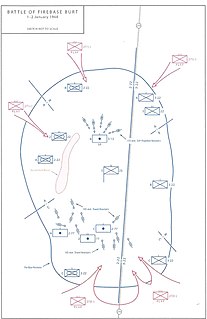 W
WThe New Year's Day battle of 1968 was a military engagement during the Vietnam War that began on the evening of 1 January 1968. It involved units assigned to the U.S. 25th Infantry Division and two regiments of the People's Army of Vietnam (PAVN).
 W
WThe action of 23 August 1967 was a major air battle which involved elements of the Vietnam People's Air Force (VPAF) and the United States Air Force (USAF). The air battle took place over the skies of North Vietnam as part of Operation Rolling Thunder, during the Vietnam War.
 W
WThe Battle of Ba Gia was a major battle that marked the beginning of the Viet Cong's (VC) Summer Offensive of 1965, during the early phases of the Vietnam War. The battle took place in Quảng Ngãi Province, South Vietnam, between May 28–31, 1965.
 W
WThe attacks on Biên Hòa, Bien Hoa Air Base and Long Binh Post, occurred during the early hours of 31 January 1968 and continued until 2 February 1968. The attacks by Vietcong (VC) and People's Army of Vietnam (PAVN) forces were one of several major attacks around Saigon in the first days of the Tet offensive. The attacks were repulsed with the VC/PAVN suffering heavy losses, having inflicted minimal damage on the bases.
 W
WOperation Bribie, also known as the Battle of Ap My An, was fought during the Vietnam War in Phuoc Tuy province between Australian forces from the 6th Battalion, Royal Australian Regiment and two companies of Viet Cong from D445 Battalion, likely reinforced by North Vietnamese regulars. During the night of 16 February the Viet Cong attacked a South Vietnamese Regional Force compound at Lang Phuoc Hai, before withdrawing the following morning after heavy fighting with South Vietnamese forces. Two hours later, a Viet Cong company was reported to have formed a tight perimeter in the rainforest 2 kilometres (1.2 mi) north of Lang Phuoc Hai, near the abandoned hamlet of Ap My An. In response, the Australians deployed a quick reaction force. Anticipating that the Viet Cong would attempt to withdraw, as they had during previous encounters, forces from the 1st Australian Task Force were inserted to block the likely withdrawal route in the hope of intercepting and destroying them.
 W
WOperation Coburg was an Australian and New Zealand military action during the Vietnam War. The operation saw heavy fighting between the 1st Australian Task Force and North Vietnamese People's Army of Vietnam (PAVN) and Viet Cong (VC) forces during the wider fighting around Long Binh and Bien Hoa.
 W
WThe Battle of Coral–Balmoral was a series of actions fought during the Vietnam War between the 1st Australian Task Force and the North Vietnamese People's Army of Vietnam (PAVN) 7th Division and Viet Cong (VC) Main Force units, 40 kilometres (25 mi) north-east of Saigon. Following the defeat of the PAVN/VC Tet offensive in January and February, in late April two Australian infantry battalions—the 1st and 3rd Battalions of the Royal Australian Regiment (RAR)—with supporting arms, were again deployed from their base at Nui Dat in Phước Tuy Province to positions astride infiltration routes leading to Saigon to interdict renewed movement against the capital. Part of the wider allied Operation Toan Thang I, it was launched in response to intelligence reports of another impending PAVN/VC offensive, yet the Australians experienced little fighting during this period. Meanwhile, the PAVN/VC successfully penetrated the capital on 5 May, plunging Saigon into chaos during the May Offensive in an attempt to influence the upcoming Paris peace talks scheduled to begin on the 13th. During three days of intense fighting the attacks were repelled by US and South Vietnamese forces, and although another attack was launched by the PAVN/VC several days later, the offensive was again defeated with significant losses on both sides, causing extensive damage to Saigon and many civilian casualties. By 12 May the fighting was over, and the PAVN/VC were forced to withdraw having suffered heavy casualties. US casualties were also heavy and it proved to be their most costly week of the war.
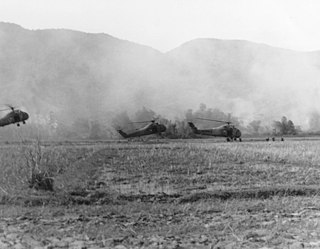 W
WOperation Essex was an operation by the 2nd Battalion, 5th Marines in "Antenna Valley", Hiệp Đức District south of An Hoa Combat Base from 6 to 17 November 1967.
 W
WThe Battle of Gang Toi was fought during the Vietnam War between Australian troops and the Viet Cong. The battle was one of the first engagements between the two forces during the war and occurred when A Company, 1st Battalion, Royal Australian Regiment struck a Viet Cong bunker system defended by Company 238 in the Gang Toi Hills, in northern Bien Hoa Province. It occurred during a major joint US-Australian operation codenamed Operation Hump, involving the US 173rd Airborne Brigade, to which 1 RAR was attached. During the latter part of the operation an Australian rifle company clashed with an entrenched company-sized Viet Cong force in well-prepared defensive positions. Meanwhile, an American paratroop battalion was also heavily engaged in fighting on the other side of the Song Dong Nai.
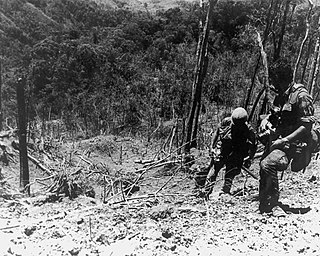 W
WThe Battle of Hamburger Hill was a battle of the Vietnam War that was fought by US Army and Army of the Republic of Vietnam (ARVN) forces against People's Army of Vietnam (PAVN) forces during Operation Apache Snow. The heavily-fortified Hill 937, a ridge of the mountain Dong Ap Bia in central Vietnam near its western border with Laos, had little strategic value, US command ordered its capture by a frontal assault, only to abandon it soon thereafter. The action caused a controversy both in the American military and public.
 W
WThe Battle of Hat Dich was a series of military actions fought between an allied contingent, including the 1st Australian Task Force and the People's Army of Vietnam (PAVN) and Viet Cong (VC) during the Vietnam War. Under the codename Operation Goodwood, two battalions from 1 ATF deployed away from their base in Phuoc Tuy Province, operating against suspected PAVN/VC bases in the Hat Dich area, in western Phuoc Tuy, south-eastern Bien Hoa and south-western Long Khanh Provinces as part of a large allied sweep known as Operation Toan Thang II. The Australians and New Zealanders conducted sustained patrolling throughout the Hat Dich and extensively ambushed tracks and river systems in the Rung Sat Special Zone, occupying a series of fire support bases as operations expanded. Meanwhile, American, South Vietnamese and Thai forces also operated in direct support of the Australians as part of the division-sized action.
 W
WOperation Hump was a search and destroy operation initiated by United States and Australian forces on 5 November 1965, during the Vietnam War.
 W
WThe attack on the Joint General Staff (JGS) Compound, the headquarters of the Republic of Vietnam Military Forces, occurred during the early hours of 31 January 1968. The JGS was located east of Tan Son Nhut Air Base. The attack by Vietcong (VC) forces was one of several major attacks on Saigon in the first days of the Tet offensive. The attack was repulsed with the VC suffering heavy losses; no material damage was done to the compound.
 W
WThe Battle of Khe Sanh was conducted in the Khe Sanh area of northwestern Quảng Trị Province, Republic of Vietnam, during the Vietnam War. The main US forces defending Khe Sanh Combat Base (KSCB) were two regiments of the United States Marine Corps supported by elements from the United States Army and the United States Air Force (USAF), as well as a small number of Army of the Republic of Vietnam (ARVN) troops. These were pitted against two to three divisional-size elements of the North Vietnamese People's Army of Vietnam (PAVN).
 W
WOperation Lam Son II was a combined United States and South Vietnamese military and public relations operation in the village of Tân Phước Khánh, Tân Uyên District, in III Corps around 40 km north of the capital Saigon staged from June 2 to June 5, 1966 during the Vietnam War. It was done in order to simultaneously win public support for the government of South Vietnam by holding a village fair and providing social services while simultaneously screening the congregated area to arrest and remove Viet Cong guerrillas operating in the area.
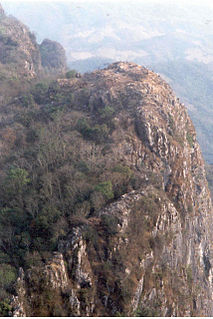 W
WThe Battle of Lima Site 85, also called Battle of Phou Pha Thi, was fought as part of a military campaign waged during the Vietnam War and Laotian Civil War by the North Vietnamese People's Army of Vietnam (PAVN) and the Pathet Lao, against airmen of the United States Air Force (USAF)'s 1st Combat Evaluation Group, elements of the Royal Lao Army, Royal Thai Border Patrol Police, and the Central Intelligence Agency-led Hmong Clandestine Army. The battle was fought on Phou Pha Thi mountain in Houaphanh Province, Laos, on 10 March 1968, and derives its name from the mountaintop where it was fought or from the designation of a 700 feet (210 m) landing strip in the valley below, and was the largest single ground combat loss of United States Air Force members during the Vietnam War.
 W
WThe Battle of Long Khanh was fought during the Vietnam War between elements of 1st Australian Task Force and the Viet Cong (VC) and People's Army of Vietnam (PAVN) during Operation Overlord. The fighting saw Australian infantry from 3rd Battalion, Royal Australian Regiment attack a heavily fortified communist base camp in Long Khanh Province, while Centurion tanks providing close support crushed many bunkers and their occupants. Regardless, the VC fought hard to delay the Australian advance and although the bunker system was subsequently captured, along with a second system further south, the Australians suffered a number of casualties and the loss of a UH-1 Iroquois helicopter. With the Australians unable to concentrate sufficient combat power to achieve a decisive result, the bulk of the VC/PAVN force successfully withdrew intact, although they probably sustained heavy casualties in the process.
 W
WThe Battle of Long Tan took place on 18 August 1966 in Phuoc Tuy Province, South Vietnam during the Vietnam War between Viet Cong and North Vietnamese units from the Viet Cong 275th Regiment, possibly reinforced by at least one North Vietnamese battalion, and D445 Provincial Mobile Battalion, and Australian forces from D Company, 6th Battalion, Royal Australian Regiment. Although the Australians were heavily outnumbered and almost overwhelmed by the Viet Cong the battle ended in a decisive victory for them, establishing their dominance over the province. This perspective however sharply contrasts with competing interpretations in which the D445 Battalion had garnered strong political support in Phuoc Tay. Furthermore, the local D445 Battalion was redeployed northwards against the newly deployed 11th Armored Cavalry Taskforce a month later and so the true significance of the battle is called into question.
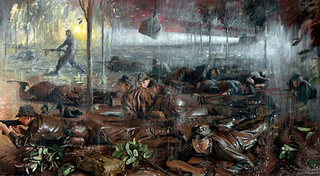 W
WThe Battle of Long Tan took place in a rubber plantation near Long Tân, in Phước Tuy Province, South Vietnam, during the Vietnam War. The action was fought between Viet Cong (VC) and People's Army of Vietnam (PAVN) units and elements of the 1st Australian Task Force.
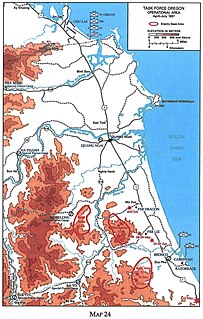 W
WOperation Malheur I and Operation Malheur II were a series of search and destroy operations conducted by the 1st Brigade 101st Airborne Division operating as part of Task Force Oregon in Quảng Ngãi Province.
 W
WThe Battle of the Mỹ Chánh Line took place from 5 May to 26 June 1972 during the People’s Army of Vietnam (PAVN)'s Easter Offensive of the Vietnam war. South Vietnamese forces, principally the Marine Division, with extensive fire and logistics support from United States forces, succeeded in stopping the PAVN advance northwest of Huế and launched a series of spoiling attacks against PAVN units. The successful defense allowed South Vietnamese forces to build up strength and then establish jumping off positions for their counteroffensive to recapture Quảng Trị Province.
 W
WOperation Oklahoma Hills was a clear and search operation during the Vietnam War mounted by the 1st Marine Division and the Army of the Republic of Vietnam (ARVN) 51st Regiment from 31 March to 29 May 1969.
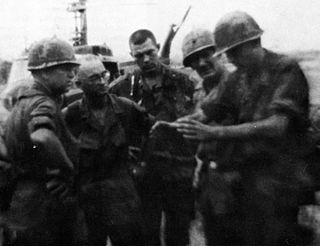 W
WThe Battle of Ong Thanh was fought at the stream of that name on the morning of 17 October 1967, in Chơn Thành District, at the time part of Bình Dương Province, South Vietnam, today in Bình Phước Province.
 W
WThe Battle of Prek Klok II occurred on March 10, 1967, during Operation Junction City when American military forces were conducting a search and destroy operation against the Viet Cong (VC) forces in Tay Ninh Province west of the capital of South Vietnam, Saigon. During the course of the operation they had already had a significant engagement in the Battle of Prek Klok I. During the night, Artillery Fire Support Patrol Base II at Prek Klok was attacked by two communist battalions, resulting in a short battle. This was the second major battle of Operation Junction City. The VC started by mortaring the base and launching anti-tank fire at the M113 armored personnel carriers (APCs) surrounding the base. Attacks came from the north and east, followed by an infantry charge out of wooded areas from the southwest. With the help of air strikes from nearby planes, as well as artillery and ample supplies flown in by helicopter, the Americans easily repelled the communist attack. The Americans killed 197 VC but lost only three of their men.
 W
WThe Battle of Lima Site 85, also called Battle of Phou Pha Thi, was fought as part of a military campaign waged during the Vietnam War and Laotian Civil War by the North Vietnamese People's Army of Vietnam (PAVN) and the Pathet Lao, against airmen of the United States Air Force (USAF)'s 1st Combat Evaluation Group, elements of the Royal Lao Army, Royal Thai Border Patrol Police, and the Central Intelligence Agency-led Hmong Clandestine Army. The battle was fought on Phou Pha Thi mountain in Houaphanh Province, Laos, on 10 March 1968, and derives its name from the mountaintop where it was fought or from the designation of a 700 feet (210 m) landing strip in the valley below, and was the largest single ground combat loss of United States Air Force members during the Vietnam War.
 W
WOperation Santa Fe was a security operation conducted during the Vietnam War by the U.S. 1st Brigade, 9th Infantry Division, the 1st Australian Task Force and the Army of the Republic of Vietnam (ARVN) 18th Division against the May Tao Secret Zone, South Vietnam from 3 November 1967 to 5 January 1968.
 W
WThe Battle of South Saigon took place from 7-12 May 1968 during the Vietcong (VC) May Offensive of the Vietnam War. 4 VC battalions attempted to advance over a series of bridges into south Saigon, but were blocked by US Army units and eventually forced to retreat with heavy losses.
 W
WThe Battle of Suoi Bong Trang was an engagement fought between US, Australian and New Zealand forces, and the Viet Cong and North Vietnamese Army during the Vietnam War. The battle occurred during Operation Rolling Stone, an American security operation to protect engineers building a tactically important road in the vicinity of Tan Binh, in central Binh Duong Province, 30 kilometres (19 mi) north-west of Bien Hoa airbase. During the fighting, soldiers from the US 1st Brigade, 1st Infantry Division and the 1st Battalion, Royal Australian Regiment, which had been attached for the operation, fought off a regimental-sized Viet Cong night assault. Repulsed by massed firepower from artillery and tanks, the Viet Cong suffered heavy casualties and were forced to withdraw by morning. After the attack, the Americans and Australians made no attempt to pursue the Viet Cong, focusing on securing the battlefield and evacuating their own casualties. The Viet Cong continued to harass the American sappers with occasional sniper and mortar fire, but these tactics proved ineffective, and the road was completed by 2 March.
 W
WThe Battle of Suối Châu Pha was fought during the Vietnam War between Australian troops and the Việt Cộng. The battle took place during Operation Ballarat, an Australian search and destroy operation in the eastern Hát Dịch area, north-west of Núi Đất in Phước Tuy province. Following a covert insertion the day before which had caught a number of Việt Cộng sentries by surprise, A Company, 7th Battalion, Royal Australian Regiment had patrolled forward unaware of the presence of a large Việt Cộng main force unit nearby. Clashing with a reinforced company from the Việt Cộng 3rd Battalion, 274th Regiment, a classic encounter battle ensued between two forces of roughly equal size. Fought at close quarters in dense jungle amid a heavy monsoon rain, both sides suffered heavy casualties as neither was able to gain an advantage. Finally, after a battle lasting several hours, the Australian artillery proved decisive and the Việt Cộng were forced to withdraw, dragging many of their dead from the battlefield after having suffered crippling losses.
 W
WOperation Swift was a military operation in the Vietnam War, launched by units of the U.S. 1st Marine Division to rescue two Marine companies which had been ambushed by the People's Army of Vietnam (PAVN). The operation took place in the Quế Sơn Valley, beginning on 4 September 1967. In the ensuing battles, 127 Marines and an estimated 600 PAVN were killed.
 W
WThe attack on Tan Son Nhut Air Base, headquarters of the Republic of Vietnam Air Force (RVNAF) and the United States Air Force (USAF) 7th Air Force, occurred during the early hours of 31 January 1968. Tan Son Nhut Air Base was one of the major air bases used for offensive air operations within South Vietnam and for the support of United States Army and Army of the Republic of Vietnam (ARVN) ground operations. The attack by Vietcong (VC) and People's Army of Vietnam (PAVN) forces was one of several major attacks on Saigon in the first days of the Tet offensive. The attack was repulsed with the VC/PAVN suffering heavy losses; only superficial damage was done to the base.
 W
WThe Tet offensive attack on the US Embassy took place on the early morning of 31 January 1968 when a 19-man Vietcong (VC) sapper team attempted to seize the US Embassy in Saigon at the start of the VC's Tet offensive. While the VC successfully penetrated the embassy compound, they were unable to enter the chancery building and were pinned down by security forces, with the lone survivor eventually surrendering to US forces. Notwithstanding the attack's failure it had a profound political and psychological impact in the United States.
 W
WOperation Wayne Grey was an operation carried out by the United States Army, 1st Brigade, 4th Infantry Division and supporting elements, on March 1 to April 14, 1969. Its main objective was to cut off lines of communication and supply to the People's Army of Vietnam (PAVN) 24th and 66th Infantry Regiments as well as preventing them from retreating into Cambodia.
 W
WThe Battle of West Saigon took place from 5–12 May 1968 during the May Offensive of the Vietnam War as South Vietnamese and United States forces countered the main thrust of the offensive against the western suburbs of Saigon.
 W
WThe Battle of Xa Cam My was fought over two days from April 11–12, 1966, 10 miles (16 km) south of the village of Cam My in Phuoc Tuy Province, during the Vietnam War. Originally planned as a U.S. search and destroy mission intended to lure out the "crack" Viet Cong (VC) D800 Battalion, Charlie Company, 2nd Battalion, 16th Infantry Regiment soon found itself fighting for survival in the rubber plantations of Cam My village, approximately 42 miles (68 km) east of Saigon. During this battle 134 men of Charlie Company, 2/16th Infantry were ambushed by the VC and 80 percent became casualties.